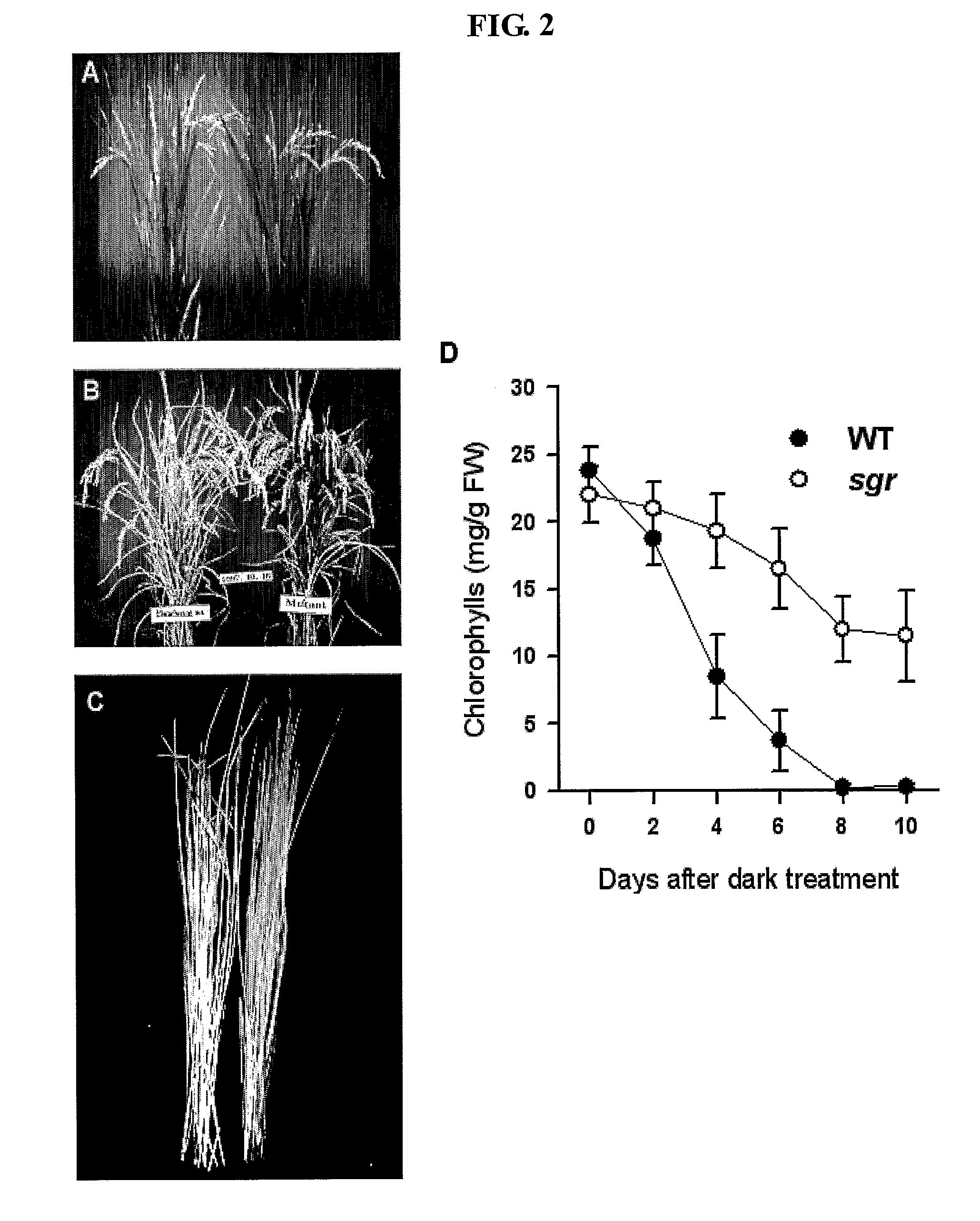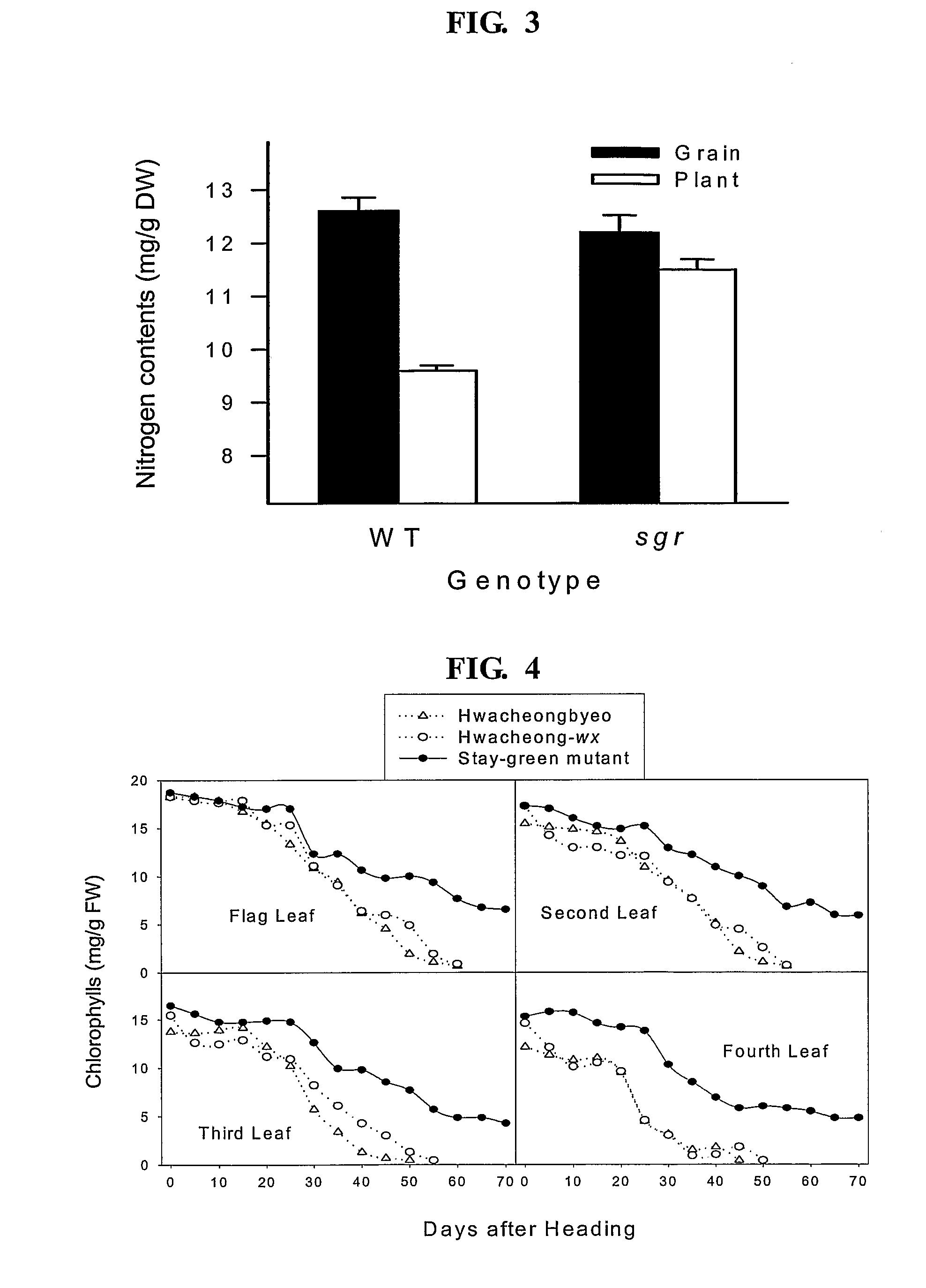A novel stay-green gene and method for preparing stay-green transgenic plants
a technology of stay green and gene, applied in the field of new sgr (staygreen) gene, can solve the problems of not yet being revealed, and achieve the effect of suppressing the expression of the sgr gen
- Summary
- Abstract
- Description
- Claims
- Application Information
AI Technical Summary
Problems solved by technology
Method used
Image
Examples
example 1
Induction of the Stay-Green Mutant Rice by the Treatment of MNU (N-methyl N-nitrosourea)
[0057] The stay-green mutant was induced by the treatment of a chemical mutagen N-methyl N-nitrosourea (MNU) in the fertilized egg cells of a glutinous rice Hwacheong-wx which is a japonica rice cultivar.
[0058] About 30,000 M2 seeds were harvested from M1 plants obtained by growing about 1,500 MNU (N-methyl N-nitrosourea)-treated M1 seeds of the glutinous japonica rice Hwacheong-wx. A stay-green mutant showing a green leaf phenotype even after grain filling was identified and isolated among M2 plants grown from the M2 seeds. During vegetative growth of the rice before heading, no phenotypic difference was observed between the wild type and the stay-green mutant plants (FIG. 2A).
[0059] The sgr mutant leaves remained green while the wild type leaves turned yellow gradually due to leaf senescence during grain filling (FIG. 2B). Also, in the case of dark-induced senescence by 2-week dark treatment...
example 2
Phenotypic and Physiological Characteristics of the Stay-Green Mutant Rice
[0060] The stay-green mutant didn't show any significant difference from the wild type on phenotypic traits such as heading date, culm and panicle lengths, panicle number per hill, spiklet number per panicle, fertility, 1,000 grain weight, grain dimension, and yield per hill (Table 1).
TABLE 1Comparison of agricultural characteristics between the wild type and thestay-green mutant1000CulmPaniclePanicles / Spikelets / GrainGrain SizeYield / HeadingLengthLengthHillPanicleFertilityWeightLengthWidthThicknessHillLineDate(cm)(cm)(No.)(No.)(%)(g)(mm)(mm)(mm)(g)Hwecheongloyeo8 / 1789.018.717.3129.092.921.74.72.71.945.0Hwecheong-wx8 / 1893.721.417.0126.791.220.34.72.71.942.6Stay-green8 / 1893.320.817.5129.592.720.54.72.71.943.0DifferenceNSNSNSNSNSNSNSNSNSNSNS
[0061] Namely, as described in the Table 1, except for the stay-green trait, various agronomic characteristics of the mutant were similar to the wild type. The only signific...
example 3
Molecular Genetic Mapping by Using Phenotypic and Molecular Markers
[0064] The present inventors disclosed that the sgr mutant gene was inherited by a single recessive gene and the mutation locus is located on the long arm of chromosome 9 in rice by using phenotypic and molecular markers (Cha, K. W. et al., Theor. Appl. Genet., 104:526, 2002).
[0065] To create the F2 mapping population to find out the locus on chromosome of the stay-green sgr mutant gene which chlorophyll degradation is suppressed during senescence, the stay-green mutant was crossed with a tongil rice cultivar, wild type Milyang23 which was bred from an indica X japonica hybridization and had a genetic makeup close to indica, thus extracting genomic DNA from the mature leaves of 305 F2 plants and the parents.
[0066] Linkage analysis using phenotypic markers showed that the sgr mutant gene was linked to Dn-1 (Dense panicle-1) gene on chromosome 9 with approximately 25% recombination value. The candidate molecular mar...
PUM
| Property | Measurement | Unit |
|---|---|---|
| molecular mass | aaaaa | aaaaa |
| concentration | aaaaa | aaaaa |
| temperature | aaaaa | aaaaa |
Abstract
Description
Claims
Application Information
 Login to View More
Login to View More - R&D
- Intellectual Property
- Life Sciences
- Materials
- Tech Scout
- Unparalleled Data Quality
- Higher Quality Content
- 60% Fewer Hallucinations
Browse by: Latest US Patents, China's latest patents, Technical Efficacy Thesaurus, Application Domain, Technology Topic, Popular Technical Reports.
© 2025 PatSnap. All rights reserved.Legal|Privacy policy|Modern Slavery Act Transparency Statement|Sitemap|About US| Contact US: help@patsnap.com



